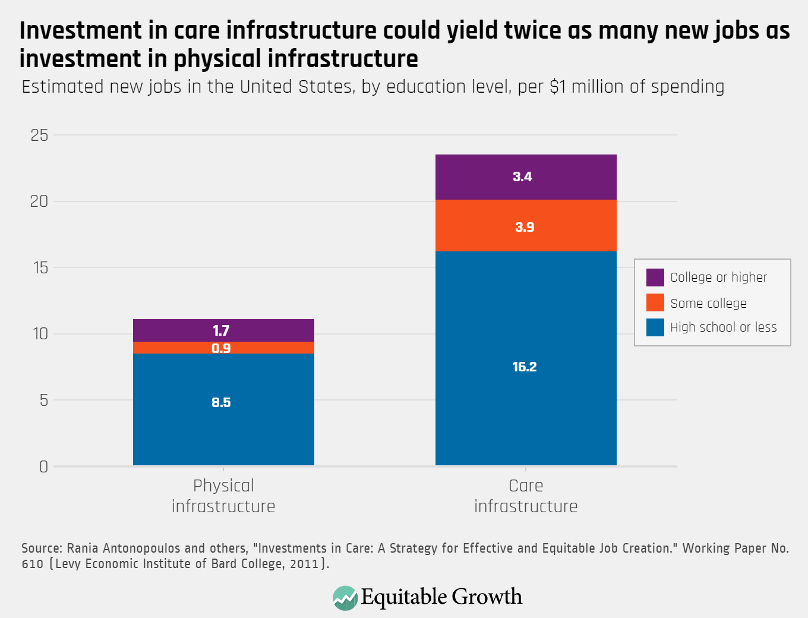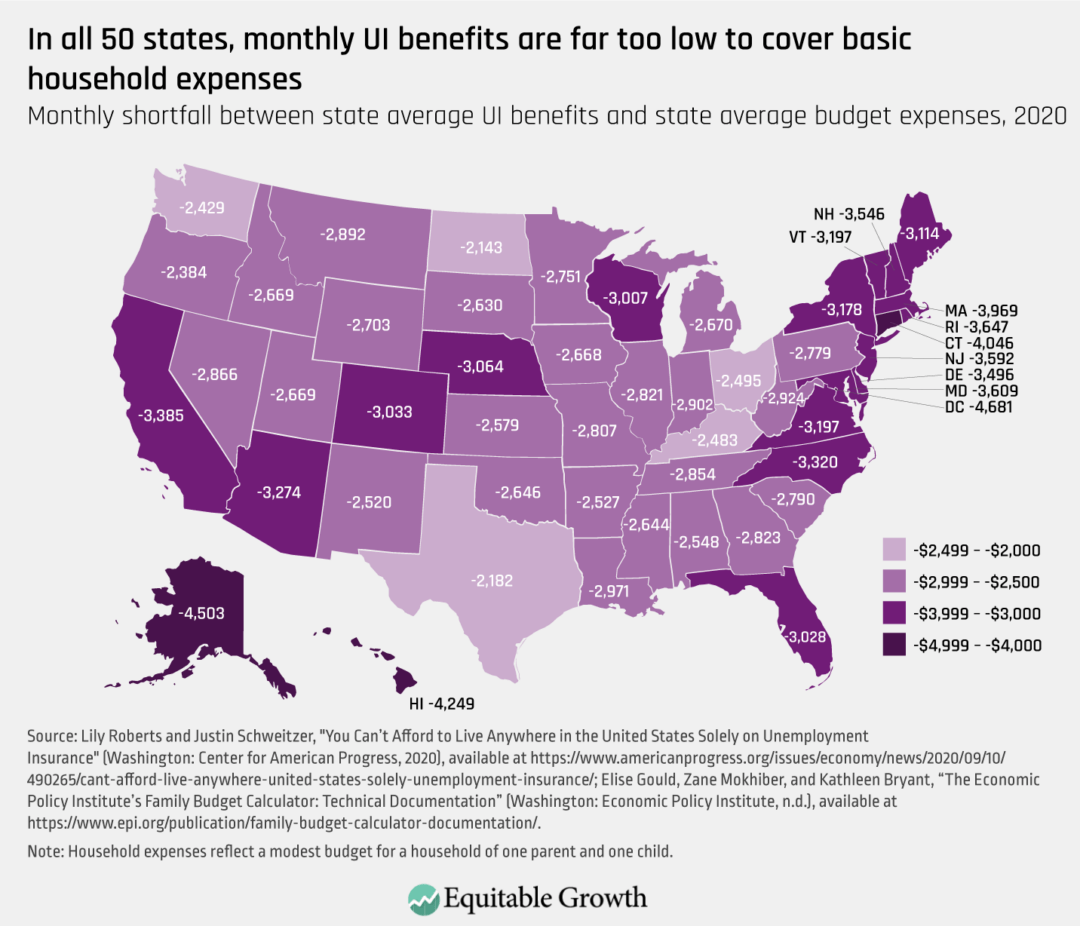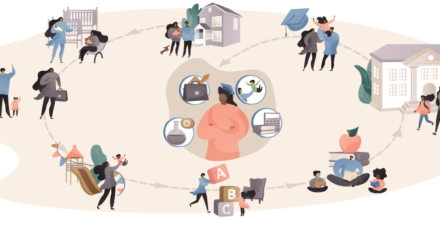Congressional investments in social infrastructure would support immediate and long-term U.S. economic growth

The U.S. Congress this month began voting on a bevy of bills and amendments designed to shore up the nation’s social infrastructure as part of a legislative process known as budget reconciliation. Based on President Joe Biden’s Build Back Better agenda, this process boasts the potential to reshape the U.S. economy in meaningful ways, by supporting workers and families with investments in care infrastructure, including a comprehensive paid family and medical leave program and increased investment in early care and education, as well as income supports, such as a permanent fully refundable Child Tax Credit and structural reforms to the Unemployment Insurance program.
Common sense, as well as a robust body of research, suggests these investments would improve workers’ and families’ personal well-being, especially for families of color who have largely been denied access to the middle class due to underinvestment in these types of public goods over the past decades. But policymakers should not lose sight of the economywide impact these investments will have as well.
To support policymakers in crafting the size, scope, and details of these investments, the Washington Center for Equitable Growth has released four factsheets summarizing the research evidence that demonstrates the economic growth potential of key programs and areas considered in the Fiscal Year 2022 budget reconciliation process:
Let’s summarize the evidence in each of these four factsheets in turn.
Care infrastructure
Through reconciliation, Congress this month can make a once-in-a-generation investment in the nation’s care infrastructure—an umbrella term for the policies, resources, and services necessary to help U.S. families meet their caregiving needs. Specifically, care infrastructure describes high-quality, accessible, and affordable child care, paid family and medical leave, and home- and community-based services and support.
Already, insufficient investment in care infrastructure strains U.S. economic growth, trapping paid care workers in low-wage jobs and forcing many unpaid family caregivers to forgo work to take care of their loved ones, costing families and the economy trillions of dollars. These challenges were exacerbated by the coronavirus pandemic and remain unforgiving amid the continuing public health crisis, as many family caregivers—disproportionately people of color—still find their caregiving arrangements disrupted and struggle rebalance work, caregiving, and other family responsibilities.
By making meaningful investments in the care economy, policymakers can undo these trends. These investments could create twice as many new jobs as investments in physical infrastructure alone while shrinking the U.S. gender employment gap in the process. (See Figure 1.)
Figure 1

Paid family and medical leave
Federal paid family and medical leave, a central component of care infrastructure, is a missing piece in the nation’s social insurance system. The United States stands alone among economic competitors in failing to guarantee workers paid time off should they need to care for a new child, a sick loved one, or themselves in the event of a health crisis. The absence of these protections is a drag on economic growth, as many workers are forced to forgo income or exit the labor force entirely when health or caregiving challenges arise.
The development of a comprehensive, well-designed paid family and medical leave program could accelerate growth across the U.S. economy by increasing rates of labor force participation, protecting families from health and economic shocks that reduce consumer spending and well-being, and supporting child development that strengthens the human capital of the next generation of workers.
Early care and education
Another important component of U.S. care infrastructure is the nation’s early care and education system. This includes a wide range of arrangements for providing care to children of all ages, ranging from informal care arrangements with family or friends to licensed child care facilities, and from universal pre-Kindergarten to targeted pre-Kindergarten programs such as Head Start.
Currently, this system is in crisis. Early care is hard to find, of inconsistent quality, and extremely expensive even though the workers caring for our nation’s children are some of the lowest-paid workers in the economy. By investing meaningfully in early care and education, policymakers can accelerate economic growth immediately through higher rates of parental labor force participation and boosted wages among the child care workforce. At the same time, child care investments support long-term growth by facilitating the human capital development of children in care.
These investments are some of the safest bets policymakers can make. Research on early care and education programs finds that every dollar in spending generates roughly $8.60 in economic benefits in the long term.
Income supports
The 2022 budget reconciliation process provides Congress with the opportunity to correct ingrained weaknesses in the nation’s income support infrastructure. Income support programs help households ensure that they have the income they need, whether through direct cash transfers in programs such as Temporary Assistance for Needy Families, Social Security Disability Insurance, and Unemployment Insurance, or by providing essential goods such as food or housing.
Research shows that such programs can lead to increased employment, facilitate job matching that benefits both workers and firms, and help build the human capital of the next generation. These benefits also have the effect of stabilizing the economy during economic downturns—for every dollar spent on Supplemental Nutrition Assistance Program benefits at the height of the Great Recession, for example, there was an additional $1.74 in economic activity.
But work remains to be done to ensure that these income support programs meet their full economic potential. Eligibility remains too strict, benefits are too hard to access for those who are eligible, and benefit levels remain too low to support families’ personal and economic well-being. Unemployment Insurance benefits, for example, are too low in every state to cover families’ basic needs. (See Figure 2.)
Figure 2

Conclusion
Economic growth that is strong, stable, and broadly shared will only be achieved by making choices that prioritize robust public investments in people and communities and sustain the workers and families who are the foundation of our economy. An adequate social infrastructure program that can deliver on its economic promise is worth the cost. And now, with the cost of borrowing at record lows, policymakers can prioritize investments in the nation’s social infrastructure at an effective discount, further accentuating the short- and long-term economic benefits of caregiving, paid family and medical leave, early care and education, and income support programs.
As the United States works to emerge from the greatest health, economic, and caregiving crisis in decades, Congress has the opportunity to correct decades of neglect to our nation’s social infrastructure. Rather than shirking this opportunity due to unfounded concerns over cost, policymakers must use the budget reconciliation process to seize this historic moment and invest in the programs and people who will grow our economy immediately and in the long term.






